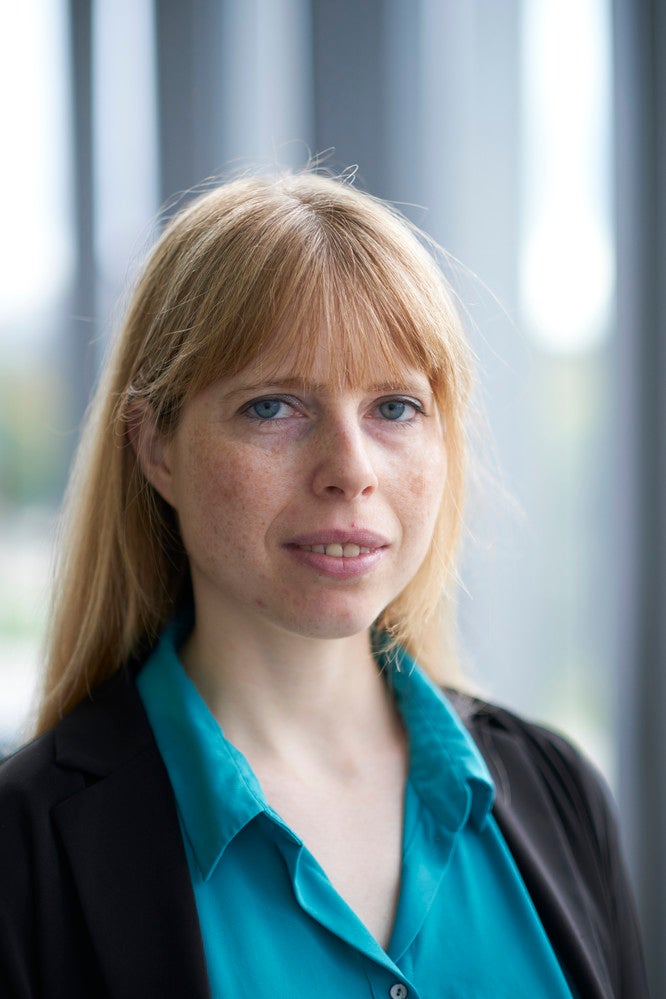New Method Enables Powerful Quantum Simulation on Current Hardware
A quantum co-processor successfully simulated particle physics phenomena on 20 quantum bits and self-verified the result for the first time, according to a new study published in Nature.
The experiment, conducted by a team of researchers in Innsbruck, Austria including Rainer Blatt, Peter Zoller and Institute for Quantum Computing (IQC) faculty member Christine Muschik, opens the door to the simulation of previously unsolvable problems in chemistry, materials research and high-energy physics.

Many scientists are currently working on investigating how quantum advantage can be exploited on hardware already available today. Three years ago, a team including Muschik, Blatt and Zoller first simulated the spontaneous formation of a pair of elementary particles with a digital quantum computer at the University of Innsbruck. Due to the error rate, however, more complex simulations would require a large number of quantum bits that are not yet available in today's quantum computers. The analog simulation of quantum systems in a quantum computer also has narrow limits.
Using a new method, researchers at the Institute of Quantum Optics and Quantum Information (IQOQI) of the Austrian Academy of Sciences have now surpassed these limits. They used a programmable ion trap quantum computer with 20 quantum bits as a quantum co-processor, in which quantum mechanical calculations that reach the limits of classical computers are outsourced.
“We use the best features of both technologies," explained experimental physicist Christine Maier. “The quantum simulator takes over the computationally complex quantum problems and the classical computer solves the remaining tasks.”
Toolbox for Quantum Modelers
The scientists used the variational method known from theoretical physics, but applied it on their quantum experiment. “The advantage of this method lies in the fact that we can use the quantum simulator as a quantum resource that is independent of the problem under investigation,“ explains Rick van Bijnen. “In this way we can simulate much more complex problems.”
A simple comparison shows the difference: an analog quantum simulator is like a doll's house; it represents reality. The programmable variational quantum simulator, on the other hand, offers individual building blocks with which many different houses can be built. In quantum simulators, these building blocks are entanglement gates and single spin rotations. With a classical computer, this set of knobs is tuned until the intended quantum state is reached. For this, the physicists have developed a sophisticated optimization algorithm that, after about 100,000 uses of the quantum co-processor by the classical computer, leads to the result.
Coupled with extremely fast measurement cycles of the quantum experiment, the simulator at IQOQI Innsbruck becomes enormously powerful. The physicists have simulated the spontaneous creation and destruction of pairs of elementary particles in a vacuum on 20 quantum bits. Since the new method is very efficient, it can also be used on even larger quantum simulators. The researchers plan to build a quantum simulator with up to 50 ions in the near future. This opens up interesting perspectives for further investigations of solid- state models and high-energy physics problems.
Built-in Self-Check
A previously unsolved problem in complex quantum simulations is the verification of the simulation results. “Such calculations can hardly or not at all be checked using classical computers. So how do we check whether the quantum system delivers the right result,” said theoretical physicist Christian Kokail. “We have solved this question for the first time by making additional measurements in the quantum system. Based on the results, the quantum machine assesses the quality of the simulation,” explained Kokail. Such a verification mechanism is the prerequisite for even more complex quantum simulations, because the necessary number of quantum bits increases sharply.
“We can still test the simulation on 20 quantum bits on a classical computer, but with more complex simulations this is simply no longer possible,” said Rick van Bijnen. “In our study, the quantum experiment was even faster than the control simulation on the PC. In the end, we had to take it out of the race in order not to slow down the experiment,” said van Bijnen.
The work now published in Nature was financially supported by the Austrian Science Fund FWF and the European Union, among others.
Publication:
Self-Verifying Variational Quantum Simulation of Lattice Models. C. Kokail*, C. Maier*, R. van Bijnen*, T. Brydges, M. K. Joshi, P. Jurcevic, C. A. Muschik, P. Silvi, R. Blatt, C. F. Roos, and P. Zoller. Nature 2019
Contact:
Kayleigh Platz, Institute for Quantum Computing, University of Waterloo
phone: 519-888-4567 ext. 30264 email: kplatz@uwaterloo.ca